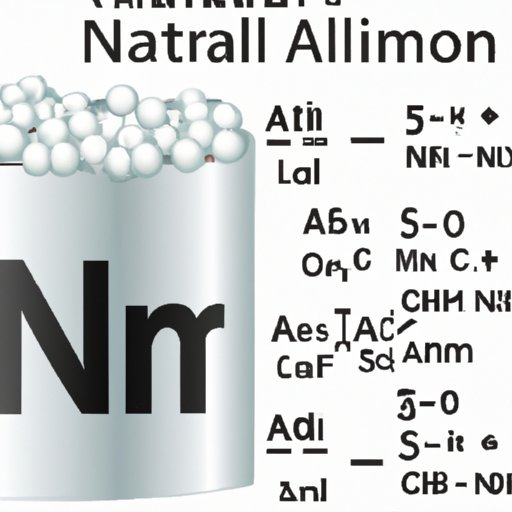I. Introduction
Molar mass is an essential concept in chemistry studies that helps in determining the molecular weight of a compound. In this article, we will explore the molar mass of aluminum nitrate, a common compound used in various industrial and laboratory settings.

II. Exploration of the Concept of Molar Mass: Aluminum Nitrate as a Case Study
Molar mass can be defined as the mass of one mole of a substance. It is expressed in grams per mole (g/mol) and is an essential aspect of chemistry studies. It helps in determining the relative quantity of reactants and products involved in chemical reactions.
Aluminum nitrate is an excellent case study for exploring the concept of molar mass as it is a common compound in inorganic chemistry that is extensively used in laboratory and industrial settings. It is also used in various applications, including wastewater treatment, papermaking, and explosives manufacturing.

III. Understanding the Atomic Composition of Aluminum Nitrate with its Molar Mass
Aluminum nitrate is an ionic compound consisting of positively charged aluminum ions (Al3+) and negatively charged nitrate ions (NO3-). Its molecular formula is Al(NO3)3, indicating that one mole of aluminum nitrate contains one mole of aluminum and three moles of nitrate.
The molar mass of aluminum nitrate is related to its atomic composition, and calculating it helps in determining the amount of aluminum nitrate present in a sample.
IV. The Significance of Molar Mass in the Formation of Aluminum Nitrate
Chemical reactions involve the breaking of bonds between atoms in the reactants and their reformation as new bonds to create products. The molar mass of the reactants plays a crucial role in determining the amount of product formed during a chemical reaction.
In the formation of aluminum nitrate, the molar mass of both aluminum and nitrate is considered to calculate the amount of aluminum nitrate formed during the reaction.
V. Calculating the Molar Mass of Aluminum Nitrate: A Step-by-Step Guide
To calculate the molar mass of aluminum nitrate, we need to determine the atomic mass of each element in the compound and then multiply it by the number of atoms present in the compound’s molecular formula.
For aluminum nitrate: Molar mass (Al(NO3)3) = [molar mass of Al x 1] + [molar mass of N x 3] + [molar mass of O x 9].
Using the periodic table, the molar mass for each element in aluminum nitrate is determined as follows:
- Molar mass of Al = 26.98 g/mol
- Molar mass of N = 14.01 g/mol
- Molar mass of O = 16.00 g/mol
Next, we substitute the molar mass values to get:
- Molar mass (Al(NO3)3) = [26.98 x 1] + [14.01 x 3] + [16.00 x 9] = 213.00 g/mol
Therefore, the molar mass of aluminum nitrate is 213.00 g/mol.
It is important to note that the molar mass of a compound remains constant, regardless of the sample size.
VI. The Relationship Between Molar Mass and Chemical Reactions: Aluminum Nitrate Edition
The stoichiometry of a chemical reaction involves the relative quantities of reactants and products involved in the reaction. The molar mass of a compound plays a crucial role in determining these quantities, making it an essential aspect of chemistry studies.
Suppose we consider the reaction between aluminum and nitric acid to form aluminum nitrate and hydrogen gas. The balanced equation for the reaction is:
2Al + 6HNO3 → 2Al(NO3)3 + 3H2
From the equation, we can see that two moles of aluminum react with six moles of nitric acid to form two moles of aluminum nitrate and three moles of hydrogen gas. The molar mass of each compound plays a role in determining the amount of reactants and products formed during the reaction.

VII. Why Knowing the Molar Mass of Aluminum Nitrate is Essential in Chemistry Studies
Aluminum nitrate is an essential compound in various applications, including industrial and laboratory settings. Understanding its molar mass is crucial in determining the relative quantities of aluminum nitrate involved in chemical reactions, making it an essential concept in chemistry studies.
This article has explored the concept of molar mass and its importance, providing a step-by-step guide on how to calculate the molar mass of aluminum nitrate. Knowing the molar mass of compounds such as aluminum nitrate helps in determining the amount of reactants involved in chemical reactions, making it an essential aspect of chemistry studies.
As a final thought, it is crucial to emphasize the importance of knowing the molar mass of compounds and its role in chemical reactions. A better understanding of molar mass not only enhances our knowledge but also contributes to the development of various applications and technologies in the field of chemistry.

